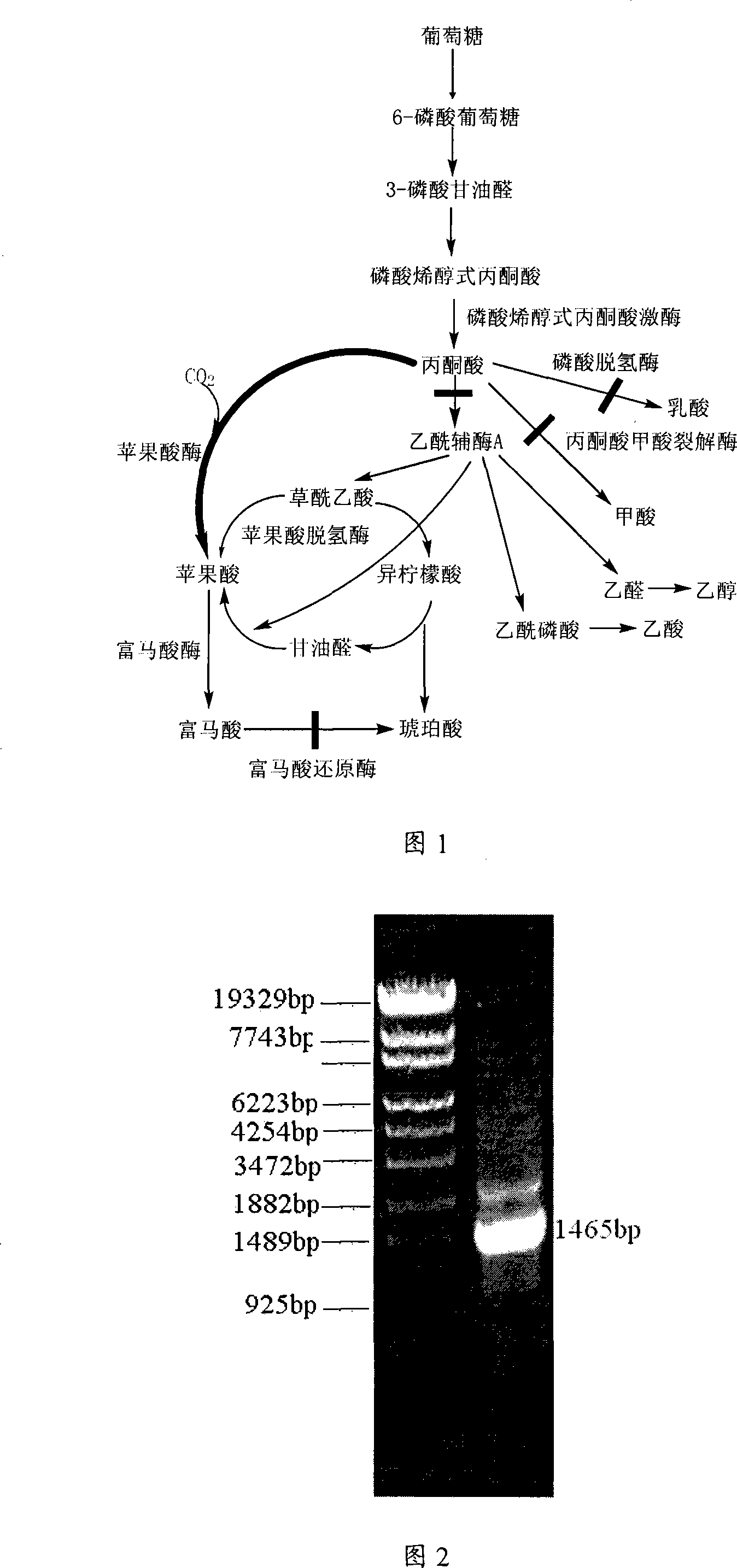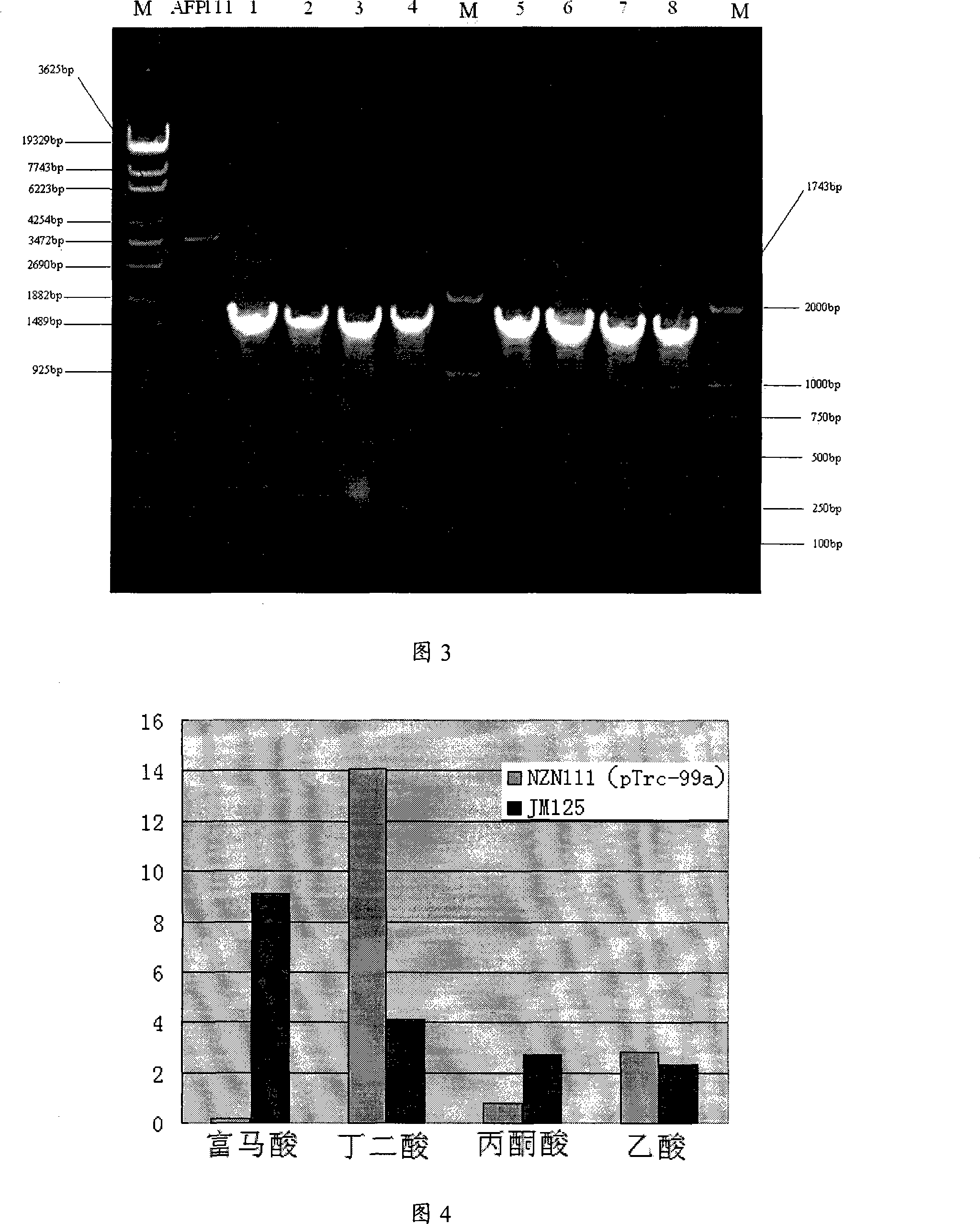Novel constructed high-yield fumaric acid gene engineering bacterium and method for producing fumaric acid thereby
A technology of genetically engineered bacteria and fumaric acid, applied in the field of bioengineering, can solve problems such as low production intensity, high price, and slow growth of mold
- Summary
- Abstract
- Description
- Claims
- Application Information
AI Technical Summary
Problems solved by technology
Method used
Image
Examples
Embodiment 1
[0034] This example illustrates the process of using homologous recombination technology to knock out the fumarate reductase frd gene in parent Escherichia coli NZN111 to obtain apramycin-resistant strains.
[0035] 1. Using LB medium, cultivate E. coli NZN111 to OD at 37°C under aerobic conditions 600 = 0.4-0.6, prepared into electro-competent state.
[0036]2. Electrotransform the recombinant plasmid into competent E. coli NZN111. The electric shock conditions are: 200Ω, 25μF, electric shock voltage 2.3kv, electric shock time 4~5ms. After the electric shock, the cells were quickly added to the pre-cooled 1mL SOC medium, cultured at 150r / min and 30°C for 1h, and then spread on the LB medium plate with ampicillin (amp) to select the positive transformant NZN111 (pKD46).
[0037] 3. Add 10mM L-arabinose to LB medium, induce plasmid pKD46 to express lambda recombinase at 30°C, and make it electrocompetent.
[0038] 4. Using the apramycin resistance gene with FRT sites on both sides ...
Embodiment 2
[0050] This example illustrates the process of constructing an expression plasmid that overexpresses malic enzyme, restoring the ability of the recombinant strain to metabolize glucose under anaerobic conditions, and obtaining the strain Escherichia coli JM125.
[0051] 1. The process of constructing an expression plasmid that overexpresses malic enzyme includes:
[0052] (1) Synthesis of primers with Nco I and HindIII restriction sites, upstream primers:
[0053] 5’-CATGCCATGGATATTCAAAAAAGAGTGAGTG-3’, downstream primer:
[0054] 5’-CCCAAGCTTTTAGATGGAGGTACGGC-3’
[0055] (2) Using E. coli K12 as template, colony PCR, the reaction conditions were 95°C, 1.5min, 63°C, 1.0min, 72°C, 1.5min, 35 cycles in total. After purifying the amplified sfcA gene, the expression plasmid pTrc99a was digested with Nco I and Hind III and ligated to obtain the recombinant plasmid pTrc99a-sfcA.
[0056] 2. The plasmid pTrc99a-sfcA was introduced into Example 1 to eliminate the competence of the apramyci...
Embodiment 3
[0058] This example illustrates the comparison between the newly constructed recombinant Escherichia coli JM125 and the starting strain NZN111 for fermentation of acid production capacity.
[0059] Escherichia coli NZN111 (CGSC7726), when introduced into the plasmid pTrc99a-sfcA, overexpressed the malic enzyme gene, restored the ability of NZN111 to metabolize glucose under anaerobic conditions, and had a high yield of succinic acid accumulation. The constructed recombinant Escherichia coli JM125, when grown under anaerobic conditions, produces a mixed acid of fumaric acid, succinic acid and acetic acid, of which fumaric acid is the main product. In order to investigate the effect of the reduction of fumarate reductase activity on acid production, a two-stage fermentation mode was adopted, and 1% (v / v) inoculum amount was inserted from the cryotube into the Erlenmeyer flask. 600 To about 0.8~1.0, induce to OD with 0.7mM IPTG 600 = About 3, transfer 10% of the inoculum to the serum...
PUM
 Login to View More
Login to View More Abstract
Description
Claims
Application Information
 Login to View More
Login to View More - R&D
- Intellectual Property
- Life Sciences
- Materials
- Tech Scout
- Unparalleled Data Quality
- Higher Quality Content
- 60% Fewer Hallucinations
Browse by: Latest US Patents, China's latest patents, Technical Efficacy Thesaurus, Application Domain, Technology Topic, Popular Technical Reports.
© 2025 PatSnap. All rights reserved.Legal|Privacy policy|Modern Slavery Act Transparency Statement|Sitemap|About US| Contact US: help@patsnap.com


